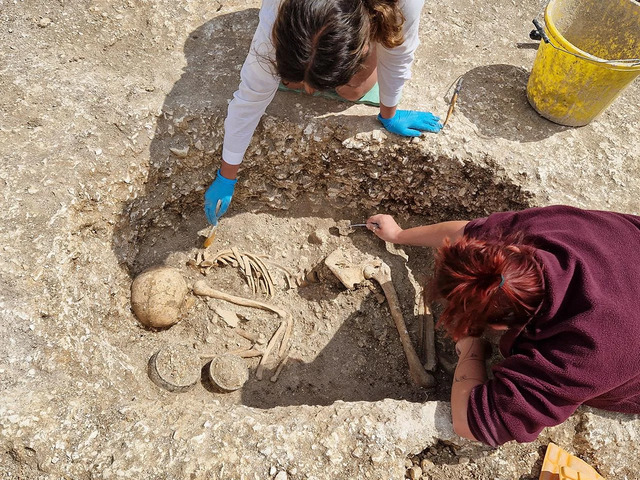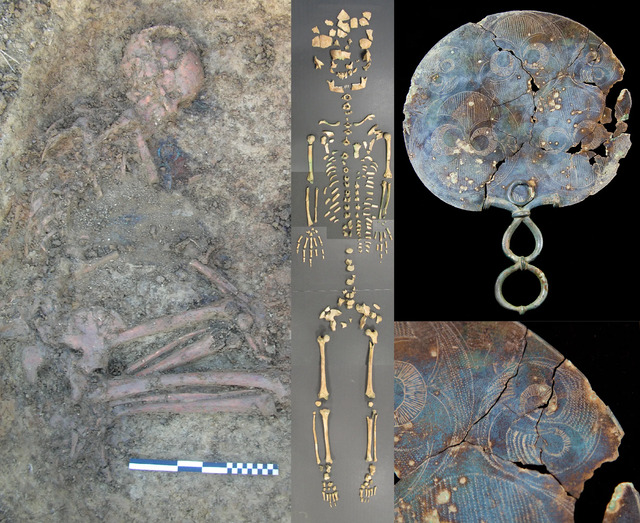In the depths of ancient British soil, a discovery has rewritten the story of Celtic society. A pioneering genetic study has revealed that women, far from being sidelined, were the driving force behind community life in Iron Age Britain. By tracing maternal lineages, researchers have uncovered a matrilocal system that challenges traditional views of gender roles, offering a fascinating glimpse into a world where women held the keys to power, land, and social structure.
The Discovery at Duropolis
The archaeological excavation at Duropolis, a site near Winterbourne Kingston in Dorset, has been ongoing since 2009. The burial ground, known for its unusually well-preserved graves, provided the perfect setting for this groundbreaking study. Archaeologists unearthed the remains of 57 individuals, most of whom were buried with valuable objects that indicated their high social standing. Through careful genetic analysis, the researchers were able to trace the family lines of these individuals, uncovering a pattern that would rewrite the history books.

Lead researcher Dr. Lara Cassidy, a genetics professor at Trinity College Dublin, and her team were able to construct a family tree that traced most of the individuals back to a single maternal ancestor. This striking finding revealed a social structure that was centered around women, with men often joining their wives’ communities upon marriage. The study’s findings challenge the conventional understanding of prehistoric European social structures, where men were typically the primary figures in family and community life.
Video
Check out the video to learn how the DNA of a Celtic tribe reveals evidence of female empowerment in pre-Roman Britain. This groundbreaking discovery challenges our views of ancient societies!
The Matrilocal Social System

The concept of a matrilocal society, where couples live near the wife’s family rather than the husband’s, is rare in ancient cultures. However, the evidence unearthed at Duropolis suggests that this was the case for the Durotriges tribe. The genetic data revealed that most of the individuals buried at the site were maternally related, suggesting that land and identity were passed down through the female lineage. This pattern of matrilocality, where husbands moved into their wives’ communities, is virtually unheard of in European prehistory but was a defining feature of the Durotriges society.
Dr. Cassidy explained that this discovery provides a glimpse into the social dynamics of Iron Age Britain, where women were at the center of kinship and community life. The genetic evidence indicates that women were likely responsible for managing property, inheriting land, and maintaining important social networks. Such a system would have given women significant social and political power, a fact that was not widely recognized in previous historical interpretations of Celtic society.

Impact of Women in Celtic Society
The role of women in Iron Age Britain was far more prominent than previously believed. The genetic findings suggest that women were not only central to family structures but also to the broader political landscape of Celtic Britain. Archaeologists have long known that Celtic women were buried with valuable items, which could signify their high status, but this new genetic evidence reinforces the idea that women had a significant role in decision-making and social organization.
The historical accounts of Roman writers, including Julius Caesar, who described British women as independent and powerful, seem to have been more accurate than previously assumed. Roman historians were often astonished by the power that women held in Celtic society, and the evidence now suggests that their assessments were not exaggerated. Women like Queen Boudica, who led a revolt against the Romans, and Queen Cartimandua, who commanded armies, were not isolated exceptions but rather part of a broader cultural trend where women wielded considerable influence.

Matriarchy vs. Matrilocality
While the genetic evidence points to a matrilocal system, it does not suggest that Celtic society was a matriarchy, where women held absolute political power over men. Instead, it indicates that women had a strong influence on social and cultural structures, particularly in relation to land and family identity. The system was not one of female dominance but rather a more egalitarian society in which women and men had complementary roles within the family and community.

The distinction between matrilocality and matriarchy is important for understanding the nuances of Celtic society. In matrilocal systems, women hold considerable power, but this does not necessarily translate into political rule. In the case of the Durotriges, women were likely the primary inheritors of land and property, but this did not mean they controlled the tribe’s political or military affairs. Instead, women’s roles in maintaining social networks and managing resources allowed them to exert significant influence over their communities.
The Wider Implications of the Findings
The study’s findings have broader implications for our understanding of prehistoric Europe. By analyzing genetic data from over 150 archaeological sites across Britain, the research team found that matrilocality was not confined to the Dorset region but was a widespread phenomenon throughout Britain. In areas like Yorkshire, the team discovered that a dominant matriline had been established as early as 400 BCE. This suggests that the matrilocal social structure was deeply rooted in Celtic Britain and may have been a defining feature of Celtic societies across the British Isles.
These findings also challenge the prevailing notion that ancient societies were predominantly patriarchal. While patriarchy has been the dominant system in many cultures, the evidence from Iron Age Britain suggests that gender roles in Celtic society were more flexible and allowed for greater equality between men and women.
Challenges in Interpreting Historical Accounts

The study also sheds light on the complexities of interpreting ancient historical sources. Much of what we know about Iron Age Britain comes from Roman and Greek writings, which often reflect the biases and preconceptions of their authors. Roman accounts of British women, for example, may have exaggerated their independence and power in order to portray the British as a more barbaric and uncivilized people. However, the genetic and archaeological evidence presented in this study suggests that these ancient accounts were not entirely unfounded.
The findings from Duropolis and other burial sites provide a new lens through which to view the history of Iron Age Britain. They suggest that women were not just passive figures in ancient societies but active agents who shaped the course of their communities and their world.
Video
Watch the video to discover how England was formed. This fascinating exploration covers the key events and processes that shaped the country’s history!
Conclusion
The discovery of a matrilocal social system in Iron Age Britain marks a pivotal moment in the study of Celtic history and gender dynamics. The genetic analysis of ancient remains has revealed a society in which women were central to community life, managing land and property while maintaining strong social ties. While not a matriarchy, this system of matrilocality empowered women in ways that were uncommon in other ancient cultures.
This groundbreaking research not only challenges traditional views of Celtic society but also offers new insights into the complex role of women in prehistory. As further studies are conducted, it is likely that even more secrets of ancient Celtic life will be uncovered, deepening our understanding of these remarkable societies.



